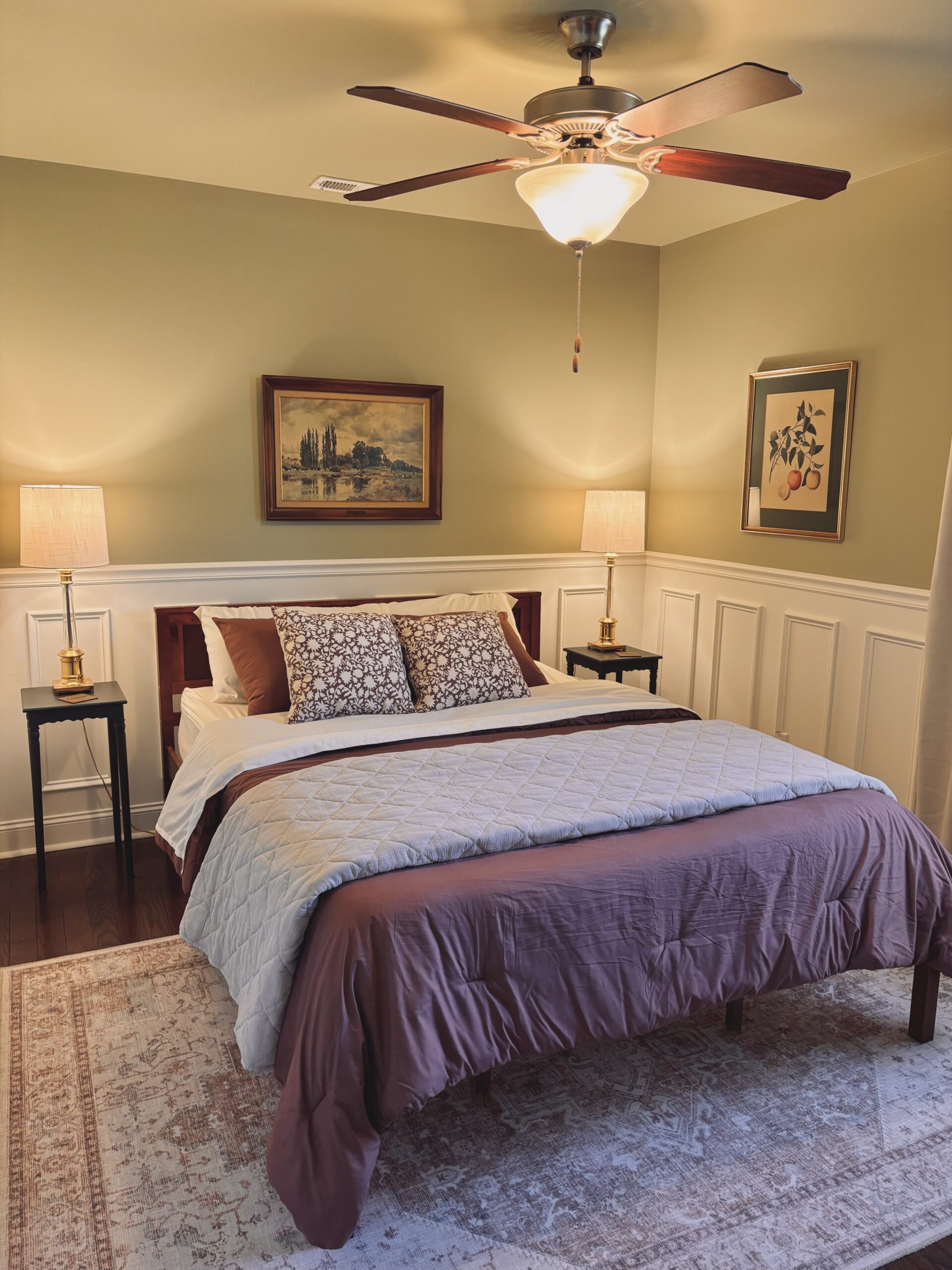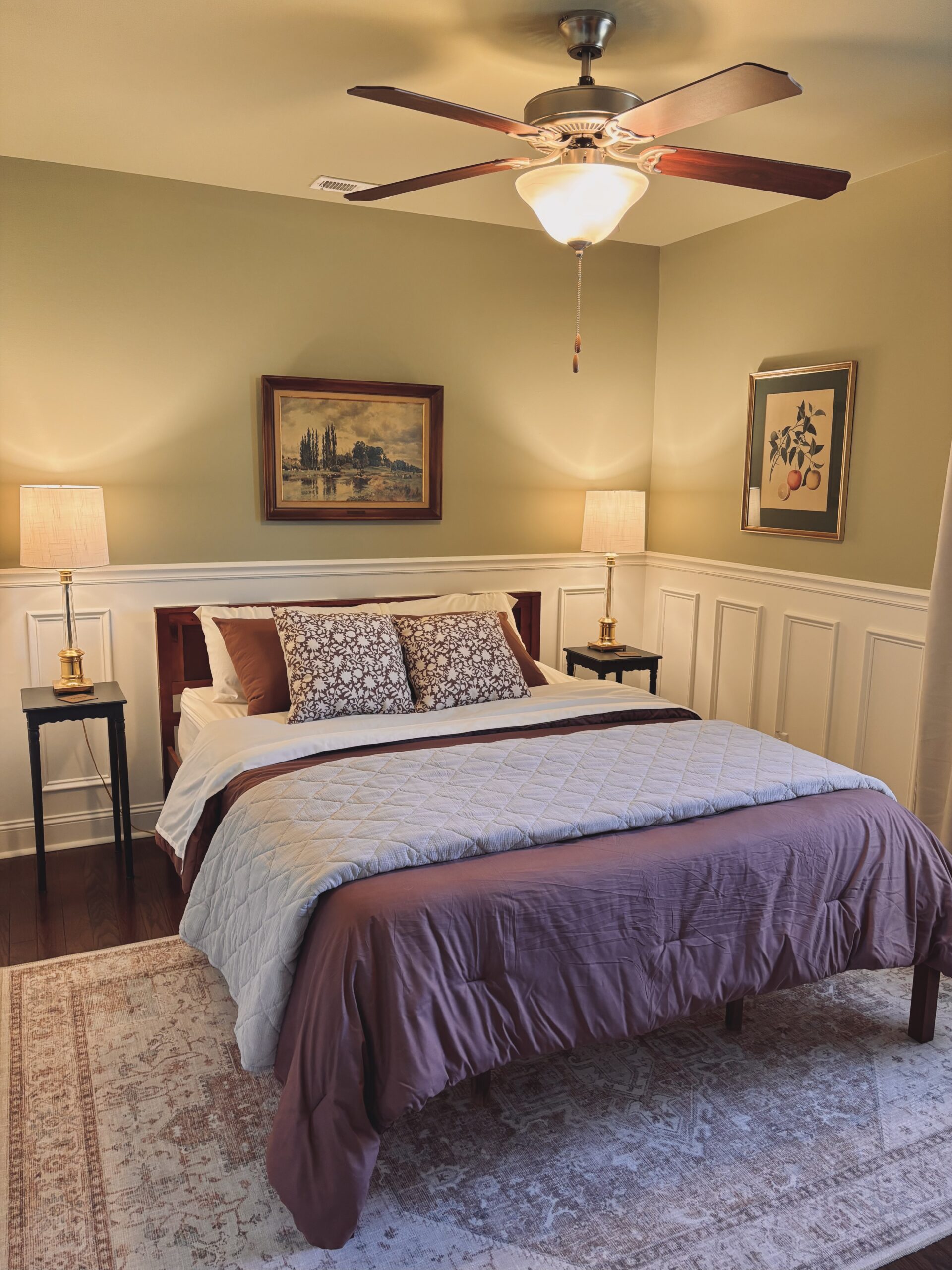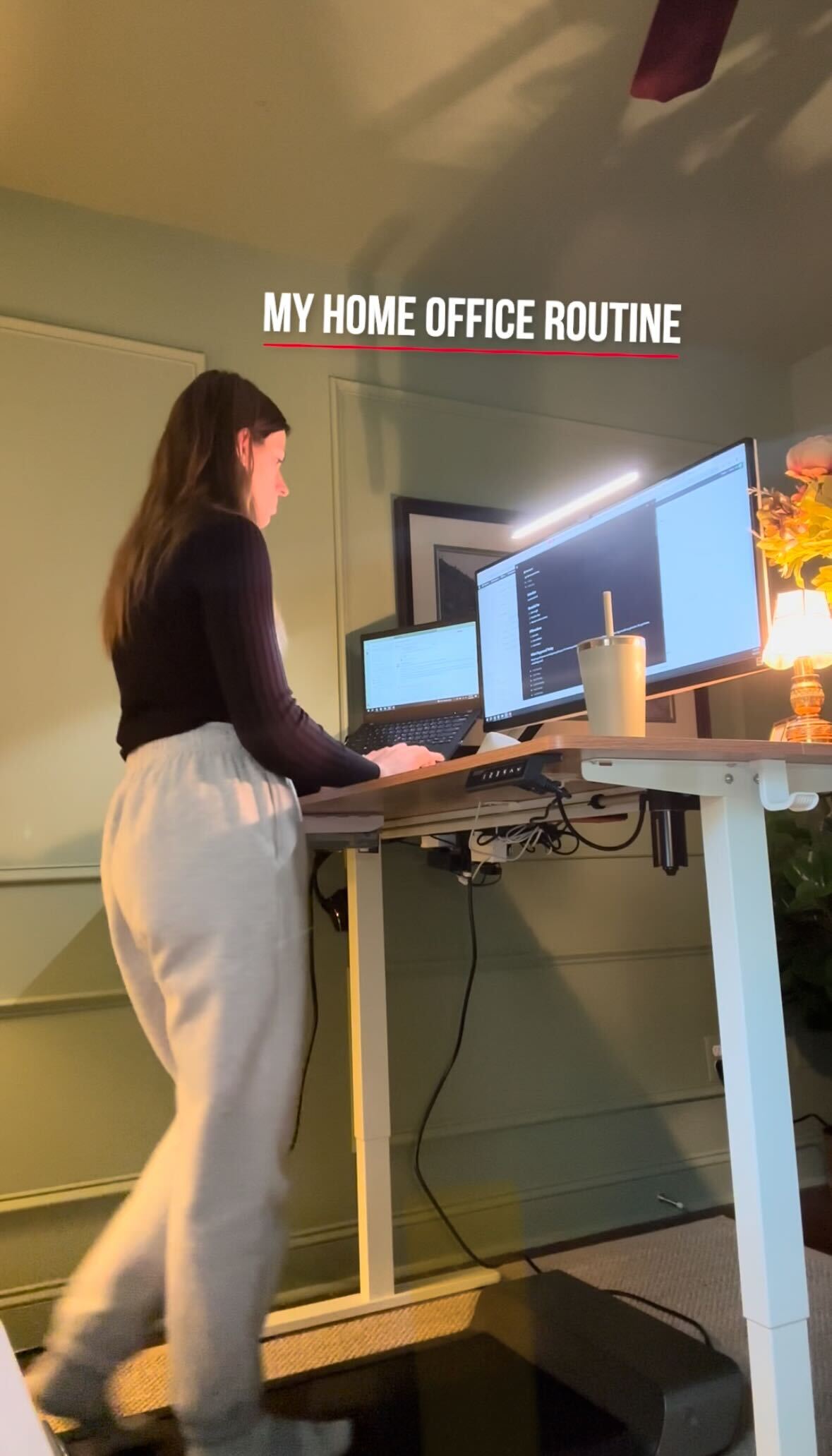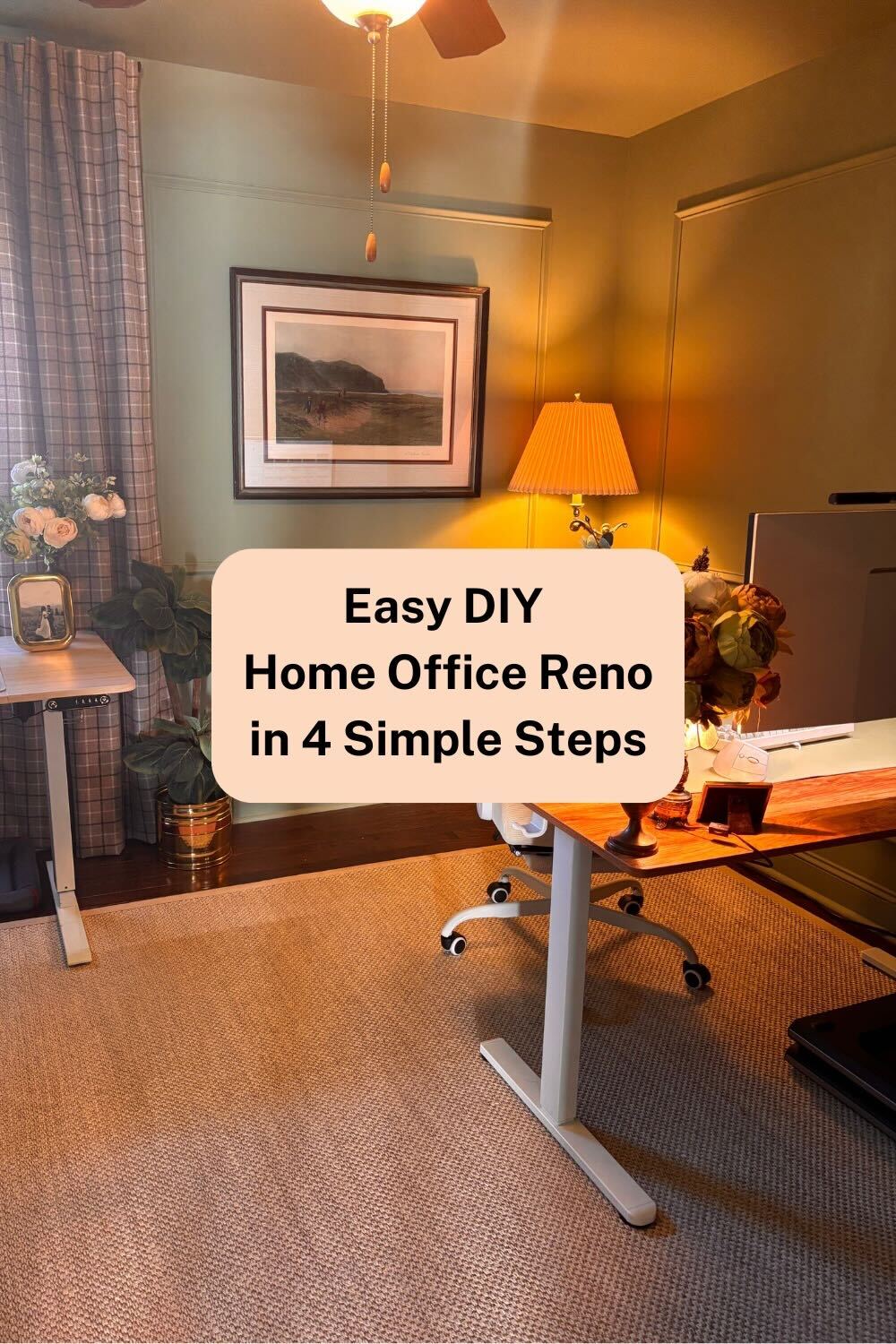So you’ve planned out a room renovation with visions of two tone paint, box trim and chair rail – now what? Continue reading for my simple 3 step plan to bring your vision to life!
In my last blog post, I discussed planning this renovation. From ideation to ordering materials. So once everything has come in, it’s time to start! Let’s get into it!
Prep & Paint
The first step is to prep your room. This would involve the following:
- Take down any art or anything hanging on the walls
- Remove outlet covers/switch plates as needed
- Patch nail holes and any other imperfections on the walls
- Remove any small furniture or decor
- Roll up the rug, fold it or cover it
- Lay a plastic drop cloth over the floor and any large furniture

If You Plan To Paint a Two Tone Room:
Now your room and belongings are ready and safe from mistakes! The next step is for those of you who are painting a two tone room. In my last blog, I discussed my plan to hang a chair rail 41 inches from the floor of my guest room. If you have a similar plan, now is the time to simply draw the line on your wall. If you have a laser level, that works great here. If not, it totally works to just measure and draw the line on the wall every few feet. This is because the line doesn’t need to be straight! The chair railing will cover the line itself. However, if you’re not planning to hang a chair rail or trim to cover this line, you’ll want to measure it precisely, tape, and paint carefully!
Painting
The room is now entirely prepped – yay, go you! Now it’s time to start painting! Typically, it’s recommended to start with a hand brush in detailed areas. So this means you’ll be painting the following areas by hand:
- Any corners or crannies where your roller can’t get in
- An outline around anywhere you’re not painting
- This would be the inside of the door jam, along the ceiling (if you’re not color drenching), along the floor, around windows, the line splitting your two tone room, etc.
- Around fixtures in the room
- If you’re color drenching, this’ll be your ceiling fan/light
- Either way, this will be around the light switches and outlets
For me, this step always requires two coats, so factor that in. But I recommend painting the detailed areas, painting the room and then returning for a second coat of both.
Now that your room has all of the details and the little spaces painted, it’s time to roll the rest of the room! I’ve shared my process in other posts, but I use an 18 inch roller. I like it because it allows me to get more coverage with each roll. However, the liners and covers are more expensive to replace. I’ll also say that it’s so long that it’s difficult to efficiently roll the paint at the end of the frame. So whatever roller you like is perfect!
Trim
Now that you’ve prepped and painted, it’s time for step 2 – trim! Let’s start at the very beginning and assume your trim just came in. That’s right, “came in.” I am a huge proponent of ordering from the hardware store (I’m a Home Depot girlie). It’s so much easier and less hassle than trying to navigate the numerous aisles and long pieces of wood that don’t fit in the car.
Cutting Trim
I’ve discussed this in other posts, but cutting trim takes a little thought and then it becomes second nature! Assuming you followed my last post and/or you have the measurements of the boxes you’ll be hanging, the cutting itself is easy. You can use any saw, really, but I love this saw! We got it for cutting floor planks when we replaced our flooring, but I’ve used it in almost every project since.
Once you’ve cut the trim to length, you now need to cut both sides at an angle to fit together like a picture frame. Personally, I find cutting quarter round really difficult mentally. However, cutting trim is really easy! I use a homemade angle, which is just a piece of wood I cut at a 45 degree angle on both sides.
Repeat the process for the chair rail and you’re done!
Trim Hanging Prep
Now that your trim is all cut, it’s time to hang! I know that using liquid nails is a thing – but I don’t recommend it. Liquid nails is great, but it makes the project permanent. If you decide you don’t like the spacing between the boxes, you make a mistake or if you/the next homeowner want to do something different in the room, you’re screwed. Using a good old fashion nail gun will secure these in place. And some caulk along the edges will give it the flush-to-the-wall look that liquid nails does.

Now, if you don’t have a nail gun or have never used one – I have some thoughts! I bought this one because it’s on the economic side. However, that means I had to buy an air compressor to get it to work. The air compressor was expensive and it’s so heavy. It’s also really really loud and it makes working with the nail gun so tedious. And the nail gun feels like a tool that is so versatile and needed in most projects. So it’s a bummer! If you don’t already have a nail gun, I seriously recommend saving up and buying an electric one. This is the one I have my eye on.
So either you have brad nails and a nailer or you’ve ordered one. In terms of nails, they can be short. It really doesn’t take much to hold trim in place! Once you’re ready to get to hanging, you’ll need a couple things to make it successful:
- Tape Measure
- Level
- Brad Nailer
- Brad Nails
Hanging Trim
It’s important to start with the lower piece of trim in each box. This will ensure they’re all the same height. I did 4 inches above the top of my baseboard. This also means I hung the chair rail 4 inches above the top of my boxes ~balance~.
- For the first of the four pieces, you’ll want to use a short level. Set the level on top of the trim and in the middle. Once you see it’s level, put a nail every 6-8 inches or so. I can’t express how light these pieces of wood are, so minimal support is needed. However, it’s good to ensure they’re as flat to the wall as possible.
- For the second piece, it can be either side piece! Line the piece up to the lower piece you just hung, making it as square as possible. Then pull out the level and make sure it’s straight. Nail in place!
- Repeat this process for the third piece. The third piece should be the opposite side piece (not the top)!
- Lay the top piece on top of the 3/4 box you just hung. It should fit nicely into the space! Use the level to make sure it’s straight and nail in place.
- Small note – it’s okay if it’s not 100% perfect. The putty you’ll use to fill the nail holes and inside seams will fix any small gaps/issues.
As a note – I tried taping the pieces up first to make sure I was doing it right and it did not work. It created such a headache! Nailing and just pulling the trim out if needed is much much easier.
Repeat the process for the chair rail!
Finishing Touches
Congrats, you’re on the last step! Now that your trim is hung, it’s time to make them look professional!
- Fill the nail holes – I do this with spackling (don’t come at me), but really any kind of putty or wood filler would work here.
- Fill the inner seams – I use spackling to fill the seams on the inside corners of the boxes. I choose spackling over caulk because it’s much cleaner to fill up and brush away excess than caulk
- Caulk the outside and inside edges of the boxes – remember to run your finger along the edges to smooth the caulk and wipe away excess. I recommend cutting the tip of the caulk bottle as small as possible. The less caulk, the easier it is to add more than it is to deal with a ton of gooping over-flowing caulk!
Repeat these processes for the chair rail!

Paint Touch Ups
Now that the box trim and chair rail look beautiful and seamless and professional, it’s time to paint! A note on painting the chair rail if you’ve gone with a two tone room – tape the flat wall that is against the top of the chair rail! It’s important to caulk with the tape because it creates a crisp line. Once the caulk is a little dry (like 20 minutes), paint with the color of the chair rail. Then you can peel the tape immediately after. Doing this will ensure the caulk doesn’t fully dry. This creates a crisp line and prevents the caulk from peeling up with the tape if it had fully dried. Repeat as needed if your paint bleeds onto the wall.
Decor
Okay, let’s review! You’ve painted the walls, hung box trim and chair railing and touched everything up. Now is a good time to put the outlet covers and switch plates back on. You’ll need to clean up after the spackling, because it gets brushed off the wall and it falls to the ground. You can wrap up the drop cloth for reuse later or throw it out. Put the furniture back and un-roll the rug. Now what?
If you’re type A like me, you may have already created a vision board for the decor in the room.

However, if not, fret not! If this is also your guest room, you’ll need the following items:
- Side tables
- Lamps
- Bed, bedding, pillows
- Curtain rod and curtains
For bonus and flare:
- Rug
- Art
- Mirror
- Throw blanket and pillows
- A luggage rack
- Coasters
- Extension cords for charging devices
- Welcome basket
Sourcing Decor
I recommend finding inspiration on Pinterest. Just type in a a keyword or two on the vibe you want. For me, I started out searching “guest room” and then Pinterest recommended to use “English country” because apparently that’s an overarching style in my entire Pinterest board collection haha. I saw soft and warm green rooms and I loved them! I also noticed notes of red, pink and orange in some of the rooms I liked. I specifically saw a floral pillow I LOVED.
So I took this info to Amazon to find some options. I found a floral pillow set that I based the rest of my decor on. A “red brick” bedding and plain sheets (idea from Pinterest) plus these floral pillows and an oatmeal throw really completed the bed!
I used the rug, side tables, lamps and curtains I already had. They’re all very neutral, so they easily worked with the bedding I bought.
I also already owned all of the art and the mirror I hung! My favorite thing to thrift is old art. I don’t claim to have excellent taste, but I know an amazing painting (to me) when I see it! I pulled out my favorite pieces, tried different sizes and prioritized my favorite prints in places that I would be able to see from the hallway – dopamine boost!

Congrats – you’re done! You’ve painted, added an interesting, professional and eye catching detail to the walls, you decorated it to your vision and put it all together!
Pop some bubbly, take lots of pictures, heck, you could even sleep in there now! Enjoy it and know your guests will too!























